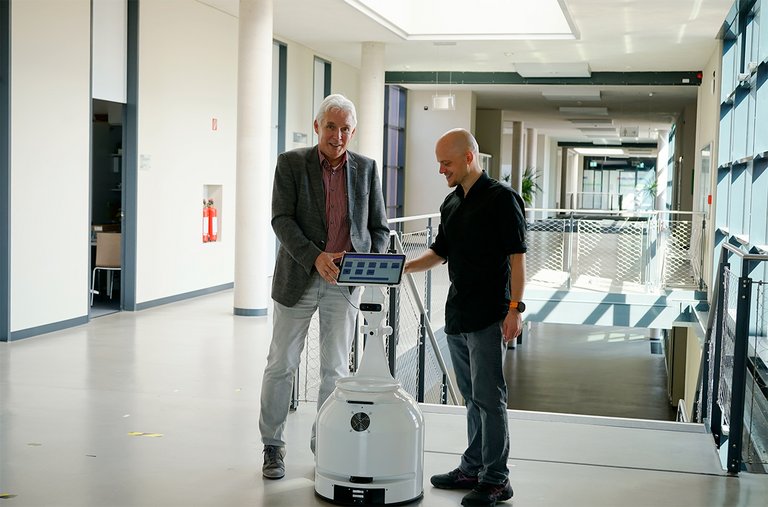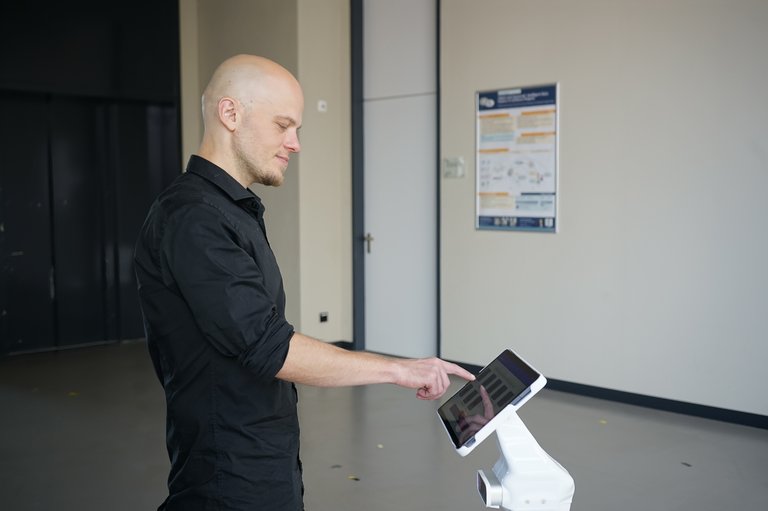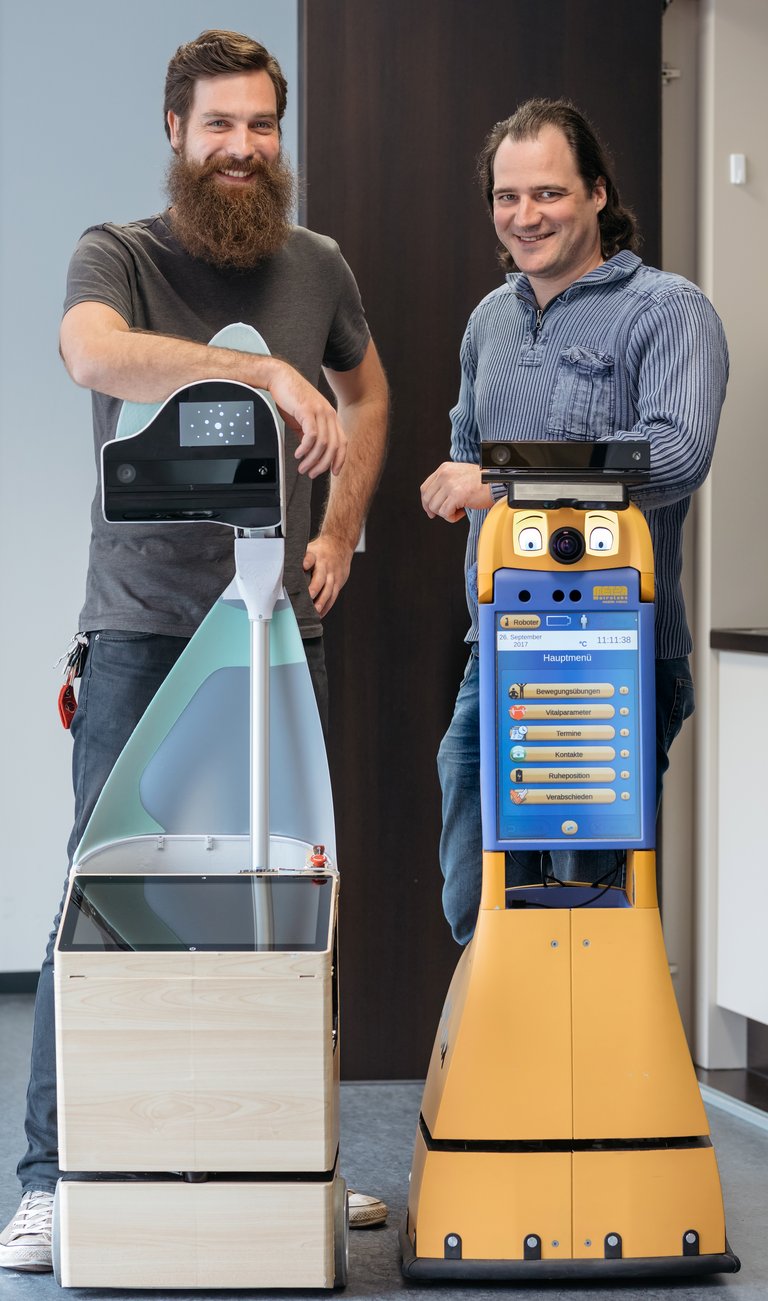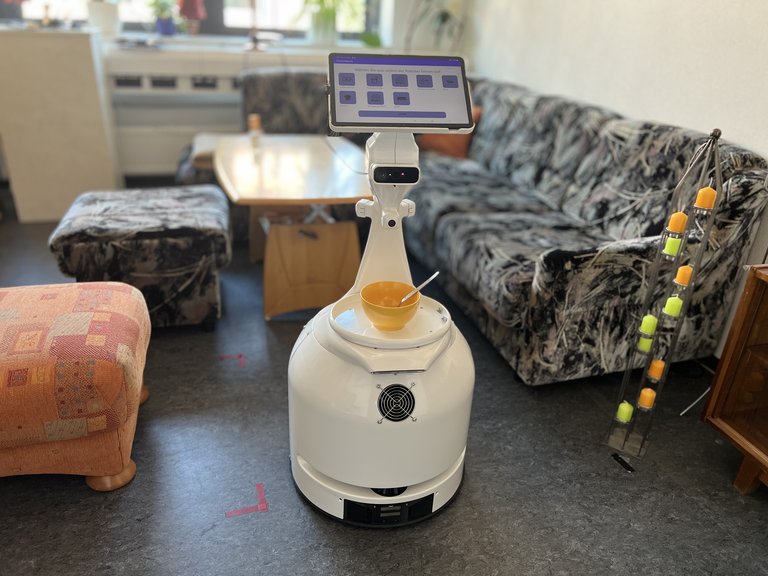With its practice-oriented focus, the Group for Neuroinformatics and Cognitive Robotics has been advancing the use of assistive robotics in care, rehabilitation and retail for 25 years. In an interview, Prof. Horst Michael Groß, head of the group, explains where robots are already relieving people in everyday life and how they can become a reliable partner in care.

Hello Prof. Groß, your group has two focal points: the development of machine intelligence and of assistance robotics. What exactly do you mean by this?
At our group we are developing social assistance robots that interact with people and provide services for them. We are pursuing different lines of application: On the one hand robotics in retail. In 1998, we started to develop shopping assistance robots, and in 2007 we were able to present the world's first shopping pilot. A second focus area concerns robots in home care, which live together as partners with a person in need of support and perform certain tasks there. The third field of application is the use of robotics in rehabilitation, for example when patients are to be motivated to walk correctly again after orthopedic surgery or after a stroke. In this case, the robot serves as a machine physiotherapist who is available in addition to human therapists outside their working hours.

These applications require a lot of recognition. The robot must recognize where a human is located, what activity he is currently performing, and how he is moving. To do this, we use machine learning methods and techniques from neuroinformatics, another mainstay of our field. We train the robots using application-specific data material so that they can then perform these tasks correctly. For example, the robot learns where a person in the apartment typically is at a certain time of day. In this respect, neural networks and deep learning methods are tools for us to make the robot intelligent. The two fields of research therefore complement each other perfectly.
How can robots support people in their everyday lives?
Robots should take over tasks that are tiring or time-consuming for humans. In rehab, for example, robots are available late into the evening and even at weekends for gait training, i.e. outside the physiotherapists' working hours. Or in retail: When we presented the shopping assistance robot TOOMAS in 2007, it was used for one and a half years as a shopping pilot in three TOOM stores. That was the first practical test: robotics is therefore not just a research topic, but can already be used in everyday life. The robot helped several thousand customers find items in the DIY store, saving them from asking questions that would otherwise have been directed to the employees. After all, most customers want to know where they can find something. That's time that employees then lack in providing customers with competent advice, for example on assembly or renovation problems.
How widespread are robots in everyday life already?
That clearly depends on the particular field of application. Retail is definitely the most advanced. Today, you can already find inventory robots in clothing stores or supermarkets as a matter of course. Robots were not used in rehabilitation until later. In this field, we had the first projects with clinics in Bad Liebenstein and Eisenberg since 2014. One of these projects also gave rise to a company, Tediro, Robotics for Therapy and Diagnostics, which aims to bring robotic assistance systems for clinics to the market. The robotic solution developed by the company is already about to be put into practice.
The use of robotics is most difficult in home care - not only because of the very demanding operating environment but also because the business models and thus the financing concepts are still lacking here. In practical tests, however, we notice that the robots are well received by seniors, but at the moment there is simply still a lack of payers, such as long-term care insurance companies.
In your field, you are working on the MORPHIA project, among other things, on the development of assistance robots in care, and are pursuing an exciting approach.
With MORPHIA, we are pursuing the basic idea that the robot is part of a care network of caregivers, relatives, friends and acquaintances. The robot takes over tasks such as transporting food from the kitchen to the living room. If a person is dependent on a rollator, both hands are not free - seemingly simple tasks then quickly become a challenge. Or if relatives are unable to reach the person, it is possible to have the robot drive around the home remotely to check on things. For example, a relative could also switch on the robot when a person in need of care is taking his or her medication to check that it is being taken. The network thus takes on a much stronger communicative role, and the robot is the mobile helper on site. From the point of view of care, this is the better way - not to make the robots ever more intelligent and autonomous, but to let them become an aid to video-based human care.

How well do your assistance robots go down with older people?
The use of robotics also has a social component. If the robots are smart, i.e. show intelligent behavior and have a friendly and patient nature, they can really be understood as partners in home care. Let's take as an example an elderly lady who lives alone. Her day is structured by herself. In a previous project "SymPartner - the sympathetic robot as partner", we tested the cohabitation of this lady as well as other test subjects with an assistance robot, a so-called companion robot, over a period of one to two weeks each. The robot greeted her by name as soon as she got up each morning - creating a feeling of not being alone. The robot supported them in their daily routine and encouraged them to do certain things. After a certain age, it's well known that people can forget to drink regularly, for example. If the robot notices this and reminds them, it is a helpful and important support. At the end of the test phase, some of the participants were really very sad that the robot left them again and would have liked to keep it.

What distinguishes the robots developed at your group?
We develop many of our robots in cooperation with the Ilmenau-based company MetraLabs GmbH. While we develop the intelligent algorithms for person perception and navigation, the company designs and builds the robots. In terms of appearance and the functions offered, we are also guided by the wishes and needs of the users, keyword user-driven design. The robot must have a relatively large footprint, for example, in order to be able to transport a plate safely. This in turn affects how the cameras must be arranged to perceive the environment. It should also have a tablet for interaction that can be operated while standing or sitting. It should also be large enough to read without glasses. Each individual component thus comes together as part of the robot's specification and is then assembled into the overall system.
How does the development of an assistance robot for use in care typically proceed?
We first develop algorithms for person perception, tracking, recognition and navigation. After a robot is designed and built, initial lab testing typically takes place in living labs. At our department, we have recreated an apartment consisting of several rooms in which test subjects can "live" for hours on a trial basis in order to test the functionality of the robots and to give the developers important clues about usage and operating problems. If these tests are successful, we will conduct real-life tests in the homes of our employees. Then initial stress tests are carried out on seniors in their own homes. Here we often discover serious differences from the laboratory environment - an 80-year-old often has completely different room furnishings than a 20-year-old, and he or she also operates the robotic components quite differently than a developer. Only when all this has been successfully run through do we then carry out field tests with the users.

You are currently focusing on applications in nursing. Do you see this as the future of your field?
From a research point of view, retail is only of limited interest to us because it is already served by companies and there is hardly any need for research on our part. The biggest challenge is the use of robotics in the home. In the future, we want to equip robots with manipulators so that they can also hand something to people. And we want to reduce their dimensions and make them so practical that they can be used in home care.
More information on the content and partners in the MOPHIA research network: www.morphia-projekt.de
Contact
Prof. Horst-Michael Groß
Head of Neuroinformatics and Cognitive Robotics

